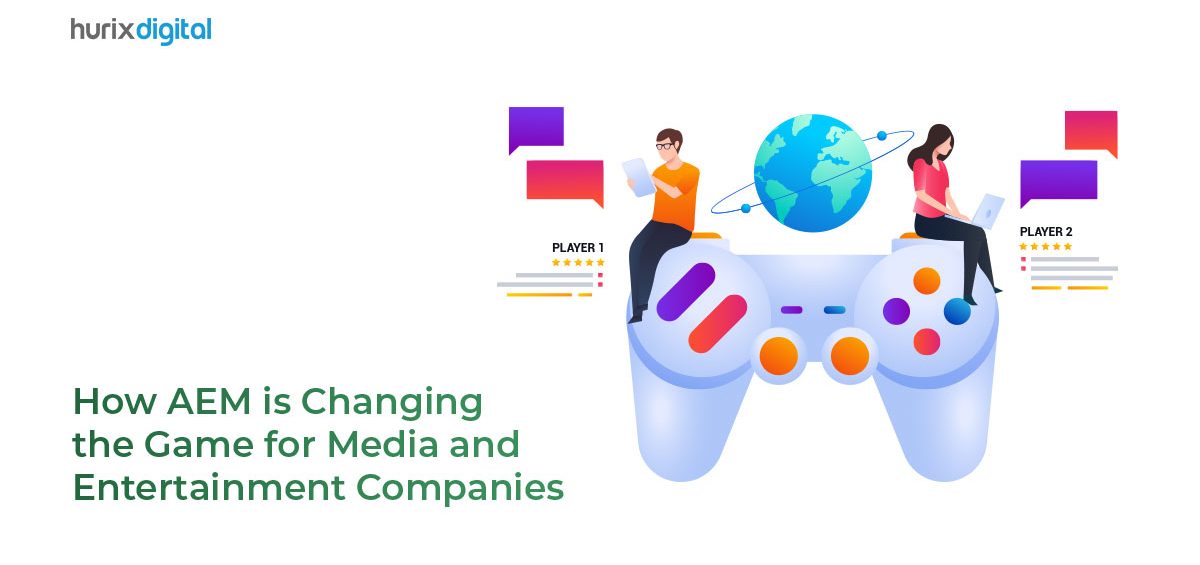Table of contents:
- Introduction
- Key Challenges in the Media and Entertainment Industry
- How Can AEM Help Address These Issues?
- Benefits of AEM for Media and Entertainment
- Best Practices for Implementing AEM in Media and Entertainment
- Key Takeaways
Introduction: The Relevance of AEM in Media and Entertainment
In today’s hyper-digital landscape, media and entertainment companies are playing the game of catchup. From managing content across multiple platforms to delivering personalized experiences to consumers, this industry has to deal with the rapid adoption of digital technology in the sector.
Fortunately, Adobe Experience Manager (AEM) is helping make this path more efficient, simple, and user-friendly.
For those unfamiliar, AEM is a content management system (CMS) that helps companies streamline content creation and management, optimize customer experiences, and improve workflows.
With its powerful features and flexible architecture, AEM is becoming an essential tool for media and entertainment companies looking to stay competitive in an increasingly crowded marketplace.
It is no wonder that around 734 companies have already shifted to AEM for their tech stack, which includes big names like LinkedIn, MasterCard, Nvidia, CocaCola, SalesForce, Intel, Microsoft, AT&T, and more.
This blog will explore how AEM transforms the media and entertainment industry and provide some best practices for companies looking to implement this powerful platform.
Key Challenges in the Media and Entertainment Industry
The media and entertainment industry face several key challenges, especially since the increasing dependence on digitization. Some of the biggest challenges include the following:
1. Management of Content Across Multiple Platforms
With the increasing use of platforms such as websites, mobile apps, and social media channels, often, companies have challenges due to time-consuming and complex processes, and each platform requires specific content.
As a result, most companies need automation to help create and manage content for different platforms and multiple requirements and formats.
2. Delivering Personalized Experiences to Customers
In a world experiencing a content overdrive, delivering tailored content per user preferences and interests is critical to standing out from the competition.
Unfortunately, media and entertainment companies often struggle in this department, as they do not have the sophisticated technology to track and analyze user behavior and deliver targeted content as per recommendations.
How Can AEM Help Address These Issues?
AEM can help companies overcome these two complex challenges in several ways. First, AEM provides a centralized platform for managing content across multiple channels and platforms, allowing companies to create content once and publish it across different channels. This saves time and resources and ensures consistency of the brand’s content across all channels.
Second, AEM’s powerful personalization capabilities allow companies to deliver targeted content and recommendations to consumers. It can track user behavior and preferences and use this data to deliver personalized content and experiences across different channels.
Benefits of AEM for Media and Entertainment
Evidently, Adobe Experience Manager (AEM) offers a range of benefits to media and entertainment companies looking to improve their content management and customer experiences. Some of these benefits include:
1. Streamlined Content Creation
AEM provides a centralized platform for managing content across different channels and platforms, allowing companies to create, manage, and publish content more efficiently. This saves time and resources and ensures consistency across all channels.
2. Improved Customer Experiences
AEM’s personalization capabilities enable companies to deliver targeted content and experiences to consumers based on their preferences and behavior. This improves engagement and loyalty and can lead to increased revenue.
3. Multi-site Management
One of the key features of an AEM is its multi-site management capabilities, which allow companies to manage content across multiple sites and languages with centralized control over branding and messaging.
4. Analytics and Reporting
AEM provides powerful analytics and reporting tools, allowing companies to track user behavior, measure engagement, and optimize content and experiences based on data-driven insights.
5. Scalability
With advanced features, AEM allows companies to easily add new sites, channels, and capabilities as their needs evolve without requiring significant IT resources or infrastructure.
Read more, Top 6 Implementation Advantages of Using AEM by Hurix Digital
Best Practices for Implementing AEM in Media and Entertainment
Are you planning to start with AEM for your company’s website or content management? While accessibility and engaging the user are essential, AEM is more than just a one-stop solution to your content process.
For media and entertainment companies, AEM can also resolve complex processes. Thus, a simple checklist to follow when implementing an AEM for your company includes the following:
- Understanding the purpose of the AEM for your brand by conducting a detailed analysis of your company’s content workflows, processes, and systems. This will help you understand areas where the AEM can add the greatest benefits and ensure the implementation aligns with your organizational goals.
- Identifying and involving the right stakeholders is also crucial to the success of your AEM project. This can help ensure that everyone clearly understands the benefits and capabilities of the AEM and provide valuable inputs and feedback throughout the process.
- Next, providing adequate training to the right resources is essential since AEM is a robust platform that requires technical expertise.
- Implementing AEM in media and entertainment companies can be a complex and time-consuming process. Developing a phased plan can help ensure that the implementation is done in a controlled and structured manner, with clear milestones and goals.
- Finally, partnering with experienced implementation partners can provide valuable expertise and support throughout the process. It can also help ensure that the implementation is done in a timely and efficient manner, with minimal disruption to existing workflows and processes.
Also read, Why AEM is the Platform of Choice for Digital Marketers
Key Takeaways
In conclusion, AEM is a robust platform that can benefit media and entertainment companies significantly.
- AEM can streamline content creation and management, improve customer experiences, optimize workflows, and provide powerful analytics and reporting tools.
- Implementing AEM requires careful planning, involvement of stakeholders, and adequate training.
- Following best practices can streamline content creation, improve customer experiences, and optimize workflows.
The benefits and use cases for AEM in media and entertainment companies are immense. However, it also takes the right implementation approach to leverage this powerful platform with the right business goals.
Working with a partner can help ensure a successful implementation with minimal disruption to existing workflows and processes, enabling companies to stay ahead of the competition in a rapidly evolving digital landscape.
Hurix Digital is an AEM implementation partner that can help you use this powerful CMS platform and get it up and running correctly. From higher scalability, personalization, security, and robust Digital Asset Management, there are multiple implementation advantages of using AEM with Hurix. To learn more, connect with us.







